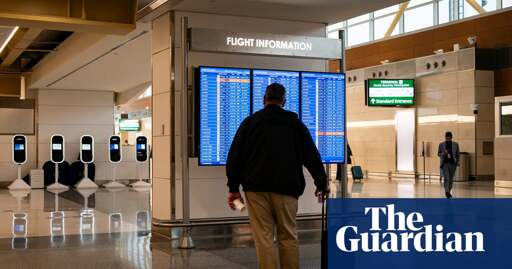Summary
A new AP-NORC poll shows that Americans’ confidence in air travel has declined after several fatal plane crashes in 2025.
Only 64% now believe flying is safe, down from 71% last year, while the number of those who feel it is unsafe rose by 12%.
Confidence in pilots, air traffic controllers, and the federal government has also dropped. Recent crashes, including a deadly collision over Washington, D.C., have fueled public concern.
Meanwhile, Trump has begun firing hundreds of FAA employees, raising further safety worries.



Even if there were 10x the number of accidents flying would still be one of the safest ways to travel.
But I’d still avoid it because of the ergonomics and customer service.
Thank you! I tried to make the same point in the comments of another recent article. This isn’t a reason to avoid air travel (yet).
However, it is a reason to criticize the Trump administration, and they deserve blame for the excess deaths under their watch. We should be hammering home the point that cutting regulation and oversight will nilly comes with life and death consequences. If it isn’t lack of FAA funding that kills you, it could be cuts to NIH, leaving WHO, turning a blind eye to corruption (which compromises quality - ask Russia), etc.
The problem is that even if it’s still safe now, these changes cannot help, and it won’t be apparent until planes start crashing.
The industry also runs on perception of safety more than the reality. If it’s perceived unsafe, then the industry could collapse quickly.
Oh, heres the thing. Even if you WERE to convince Trump that his own direct decisions is what led to the deaths of hundreds of people? He would just shrug and not care.
Which you wouldn’t be able to do because narcissists don’t have the ability to accept that they’re at fault for something.
Firing several hundred people in a profession vital to safety that’s already stretched thin, implementing a hiring freeze so they cannot be replaced, and them blaming DEI practices for the recent crashes is certainly not going to help a thing. I have yet to see anything he’s done that is actually beneficial. I mean, I agree with the penny bit, but you can’t just bibbidy bopity boop them out of circulation.
Airplanes aren’t as safe as trains!
And the externalities from air travel are fucking horrendous.
Totally! And trains are so much more comfortable and I don’t have to let them take my nudes before I get on.
As much as I actually like driving if I’m going to a city with good transit I vastly prefer the train. Plus the stations are usually right downtown.
The downtown stations are so very nice. I love rolling right into the core and being a few minutes from everything.
Having to train in from the airport isn’t bad, but after a long trip adding another hour to get from the airport to downtown is annoying. Of course, many US cities don’t have a train from the airport to downtown, so that only applies in developed locations.
One of the upcoming wacky infrastructure choices is the high speed rail in Las Vegas to LA. On the Vegas end the train station is out of town like it’s an airport. So you train from LA to Vegas and then… bus in? Join a massive line of taxis/ubers? It’s so very clumsy. Why the casino operators didn’t find a way for the rail station to be in the center of the strip so people fall of the train and into their casinos is still beyond my ken.
In the US, air travel is safer by an order of magnitude. According to the National Safety Council, scheduled airlines have a passenger fatality rate per 100,000,000 miles of 0.001 while rail has a fatality rate of 0.025. Hell, busses are safer with a fatality rate of 0.0066.
I’m sure rail safety is probably better in Europe and Japan since they have better rail infrastructure and more passengers.
A /r/dataisbeautiful post from several years ago also shows a similar story.
I don’t disbelieve you but you’re cherry picking one of the worst examples (possibly exceeded by Canada because of Lac-Mégantic) hell, the disaster that just happened in East Palestine, OH is an excellent study in just how awful train safety in the US is.
I averaged data from 2016 to 2022. What am I cherry picking?
I more meant that the safety of trains in the US shouldn’t be used as an example for overall train safety. Other countries have much more stringent laws.
Ditto, with Canada, there are serious issues with how train safety is conducted since the majority of train traffic is freight.
But the US doesn’t have other rail systems, so an apt comparison is US planes to US trains.
My original claim was that trains are safer than airplanes - I don’t know why we’re focusing on the US.
There were no passenger deaths for the derailment in East Palestine.
The East Palestine derailment investigation revealed a lot of flaws in safety checks and how over worked conductors were - I mentioned that incident less as a cause of danger and more due to how awful US safety laws on trains are.
Why doesn’t this compare time spent traveling over mileage traveled (genuine question)?
One would expect the vast majority of planes to be faster than the vast majority of trains, so of course they’d have less accidents per mile traveled even if the same number of accidents occurred (I think).
Whereas with time spent, maybe as an additional data point, it becomes fairer to compare, right?
Wikipedia does a good job explaining after the chart here.
Most people aren’t riding trains or buses hundreds of miles at a time, and there are FAR more people riding trains and buses. So per hour traveled, those will be safer.
But while you don’t take planes from say, one part of NYC to another, you CAN take trains and buses to other cities. So mileage becomes a more meaningful comparison. Sure a bus might be safer per hour, but a bus ride from NYC to LA will take many more hours than a plane ride.
It’s because passengers (mostly) use transportation to get somewhere, not to waste time. The benefit is the distance traveled, and the risk is death. If I had the option to travel to a city 500 miles away by bus or by plane, I would want to fairly compare my chances of dying by one method vs the other
I wouldn’t want to find out if traveling 1.5 hours by bus or 1.5 hours by plane was riskier. That would be apples and oranges. The bus trip might only take me 30 miles, while the plane trip would take me 500.
My confidence in air travel fell completely after the former head of QA for Boeing’s plane factory said he wouldn’t get on a Boeing plane
I always forget what makes it the safest mode of travel.
If it’s the safest per KM, then it doesn’t matter when it’s the only way to travel.
If it’s the safest per trip, again, there often isn’t an alternative.
Is it still the safest mode of travel per time spent travelling? Because I’d imagine trains generally surpass that. And hopefully walking too in most places…
I think per hour travelled bus and train edge out airplanes simply due to the sheer number of people riding those forms of transit every day. But not by much.
According to Wikipedia, it’s 11.1 deaths per billion hours for bus, 30 for rail, and 30.8 for air.
Edit: It’s important to note that you can’t really directly compare based on those values. Wikipedia explains why after the chart. Taking a bus from NYC to LA would be more dangerous than taking a plane from NYC to LA, even if an hour on a bus is safer than an hour on a plane, because of the number of hours the bus would take to get to its destination.
We’re also dealing with a baseline of relatively low numbers. That means it only takes a few additional deadly accidents to become 10X worse.
There are not actually anymore crashes than usual. The one that killed 67 was big so there is a focus on them for a while. Same thing happened after the East Palestine train derailment. Not that deregulation (and Trump) hasn’t fucked things up overall but there is not some sudden jump in crashes.
I’d say this is at least more than 50% BS as the “number of incidents” you’re referring to are mostly comprised of extremely minor things that have to be reported by law. Your train derailment example would include things like a rail car popping off the tracks inside a train yard while getting pushed around and loaded which is fairly inconsequential and shouldn’t be compared to or lumped in with something like a major derailment where toxic chemicals are dumped all over a community and then lit on fire same with plane crashes and midair collisions like we’ve been seeing.